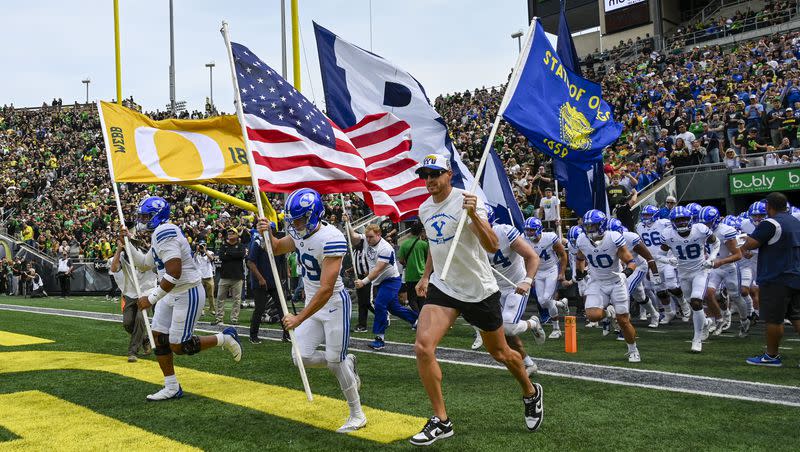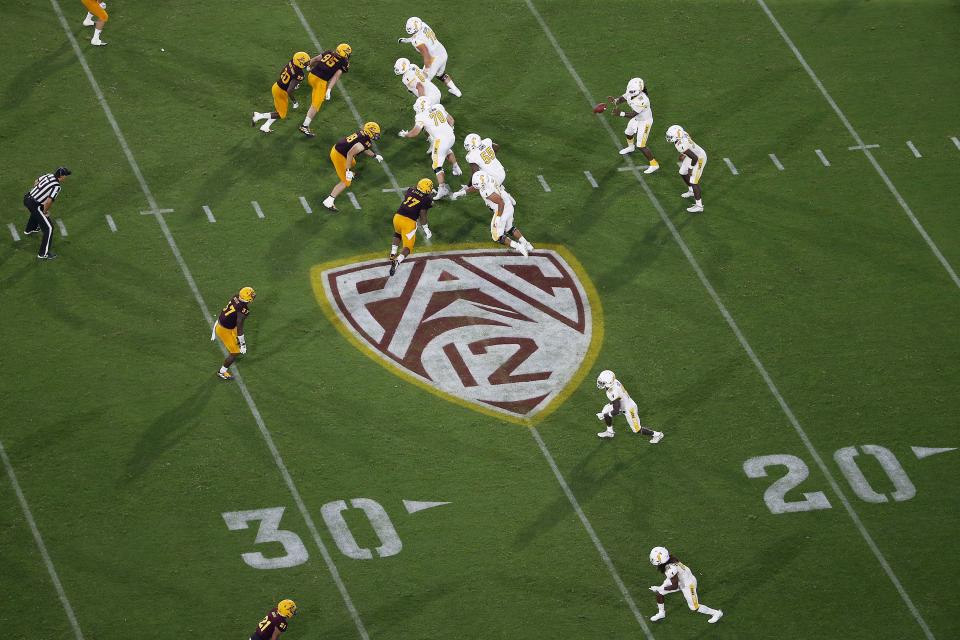Experts say Pac-12 really could have used BYU when it comes to media rights negotiations

When the Big 12 added BYU, it may have made all the difference in the muddled world of college football media negotiations we have been witnessing with the Pac-12 the past nine months.
The Pac-12 is losing UCLA and USC and considering expanding to help in negotiations with Apple, Amazon and other potential media partners. The 10 remaining teams have vowed solidarity. Last week presidents at Utah, Arizona and Arizona State made positive public declarations of hope that all will be just fine and negotiations will conclude very soon.
The Pac-12 presidents passed on adding BYU eons ago and repeated that in 2010 when Texas and Oklahoma turned down invitations that ultimately went to Utah and Colorado.
It became very clear in the past two decades that the Pac-12 did not want to include a religious institution like BYU, declaring “cultural fit” and “research institution” qualifications in its exclusivity decisions.
But from a purely athletic and football brand perspective, many experts are now declaring that was a shortsighted move by the “Conference of Champions.” One that is costing them now.
CLIP: Pac 12 TV negotiations are dicey
POD: https://t.co/knns4btvkj pic.twitter.com/fd7Dxav9pW— Andrew Marchand (@AndrewMarchand) March 22, 2023
One of the most dependable media critics in the country, New York Post columnist Andrew Marchand, called the Pac-12 negotiations going on right now “dicey.” In contrast, Pac-12 media folks, quoting AD sources, say talks are encouraging.
For the record, the Pac-12 will never, never, ever invite BYU to be part of its conference. And it has nothing to do with sports or academics. But a writer for Forbes, a media expert, said BYU is a “money shot.” That is a reference to what moviemakers consider a scene or moment that makes the production a commercial success.
Related
That’s one reason an invitation to the Big 12 rings so loud in Provo these days.
Pac-12 presidential hubris, however, may now cost the remaining schools millions.
It’s not just me saying this — it comes from voices from both coasts with no connections to BYU.
Writing in The Athletic, national college sports editor Stewart Mandel wrote:
“The one school the Pac-12 could have added anytime the last 40 years that would have created value is BYU. But generation after generation of league presidents made it clear they wanted nothing to do with a church-owned university that’s not a research institution, just like they’ve thumbed their nose at Boise State. Now they‘re down to the likes of San Diego State and SMU, which would help keep their roster at 12 but will not move the needle in terms of interest from media partners.”
Jim Williams, a writer for Forbes and former employee at ESPN, told 356 Sports in Texas this week a remarkable money figure associated with the Big 12 when former commissioner Bob Bowlsby spearheaded the addition of BYU, Houston, Cincinnati and Central Florida.
Having $$$'s and having a deal are two widely separate things. Case in point...the AppleTV+/NFL Sunday Ticket negotiation. The price portion was basically done but terms couldn't be resolved. Deal cratered. Deals do die over terms. https://t.co/QulMM4RSWM
— Bob Thompson (@rltsports) March 22, 2023
Williams was asked what stood out about what the Big 12 did with expansion and what tactics stood out to get a $31.6 million per team payout with an early negotiation.
“First off, we have the credibility for going out and expanding,” said Williams.
“And I don’t think he (Bowlsby) gets enough credit for that one. The money shot was BYU. And the reason the money shot was BYU is back in 2010 when the shift came, and again in 2015 and when we started getting people in, I had been involved in some of that in both times. ESPN was telling me, you know how much BYU is worth? BYU is probably the difference between $27-28 million and $31.6 million (per team, per year) in that contract.
“So, BYU alone, was probably kicked into the $31.6 per team. So you’ve seen them go from $27 to $31 million (TV deal signed last fall). So that was good on Bowlsby.”
Related
When current Big 12 commissioner Brett Yormark jumped the line and negotiated a TV contract ahead of the Pac-12 last summer, the combined ESPN and Fox deal is reportedly a six-year $2.2 billion payout, or $31.6 million per team per year.
If BYU adds approximately $4 million per year, as Williams postulated, that figure would be $240 million over the remaining five years of the contract (2024-29) when there are 12 teams. Texas and Oklahoma football leave the Big 12 after the 2023 season, a year in which there will be 14 teams.
Without poaching a team from the Big 12 or ACC, the Pac-12 is not going to realize that kind of value in the coming days or weeks when it actually announces expansion or a new TV deal.
And that’s on Pac-12 presidents, not their commissioner George Kliavkoff.
For generations.
This is just an interesting thumbnail note to file away when the smoke clears on the Pac-12 deal. BYU is very happy with where it landed. The Pac-12 was never an option, and that’s fine.
But when the Pac-12 eventually does get a deal and you line up the numbers, it will be interesting if it matches the Big 12’s $31.6 million. Last week we heard from Pac-12 folks that meeting the $31.6 million would be “a layup” and presidents were confident the new TV deal would meet or supersede that figure.
What if it comes in at $27 million or, say, $24 million?
What could have made the difference?
Of course, it’s all moot, and really moot if the Pac-12 deal is worth more than the Big 12.
But it’s an interesting talking point as all of this goes down.
The assertion here is BYU’s value was an asset the past decade, especially this summer when Yormark negotiated a media deal. Today, it would appear from the Pac-12’s delay in finding a TV contract that the economy has changed. ESPN and parent company Disney is lopping off 7,000 employees and Amazon has laid off 16,000. Apple has a ton of money, but that makes Tim Cook all the more powerful to get his way at his price.
Oregon columnist/blogger/radio host John Canzano tweeted on Wednesday the Pac-12 CEO group was meeting this week and that ESPN, Apple/Amazon and Fox are involved.
The next CEO meeting of league officials is planned for early April.
Correction: The $4 million added BYU “money shot” described by Forbes writer Jim Williams, is more accurately described as a $240 million added value over the span of the Big 12 contract with the new 12-team league beginning in 2024.


